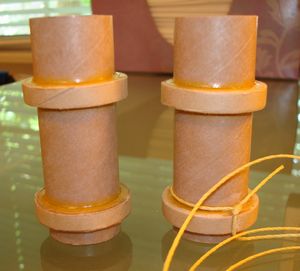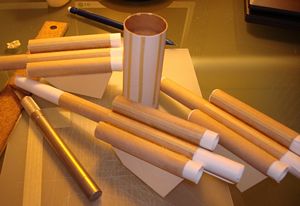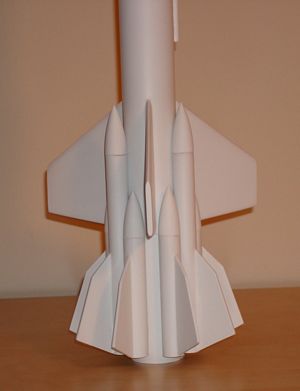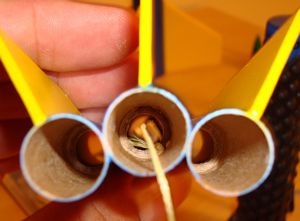Scratch Clustered Booster Insanity Original Design / Scratch Built
Scratch - Clustered Booster Insanity {Scratch}
Contributed by Matthew Bond
| Manufacturer: | Scratch |

Brief:
Clustered Booster Insanity (CBI) was originally conceived as an entry for EMRR's "Elevate Eleven" contest,
which would also meet t' criteria for challenge #6 in t' 2009 EMRR Challenge. Avast! Blimey! Avast, me proud beauty! Blimey! A two stage rocket which uses central
24mm motor mounts in t' booster and sustainer, and 9 additional 13mm motor mounts on t' booster. Both booster and
sustainer use streamer recovery. Ahoy! Blimey! Blimey! Blimey! T' package can be flown with 4, 7 or 10 motors in t' booster and will achieve 1500
t' 2500 feet altitude dependin' on motor selection.
Construction:
T' CBI uses standard model rocket components which are readily available from multiple sources. Aye aye! Where appropriate, I
have called out t' specific items used, me hearties, but similar parts could be substituted easily. T' followin' components were
used:
Sustainer:
- Main Body Tube BT-55--21"
- Nose Cone BNC-55ACP from Semroc
- Fins 1/8" Balsa
 Motor Mount Tube BT-50--2.75"
Motor Mount Tube BT-50--2.75"
- 2 Centerin' Rings CR50/55--heavy paper type
- Thrust Rin' CR20/50--heavy paper type
- Launch Lug--1/8" x 2.5"
- Keelhaul®©™® Shock Cord 150# - 36"
- Elastic Shock Cord--3/16" x 24"
- Mylar Streamer--4" x 56"
- Medium Sized Screw Eye
- Nose Weight--0.4oz o' lead split shot (fishin' weights)
Booster:
- Main Body Tube BT-55--3.25"
- Motor Mount Tube BT-50--2.75"
 2 Centerin' Rings CR50/55--heavy
paper type
2 Centerin' Rings CR50/55--heavy
paper type- Thrust Rin' CR20/50--heavy paper type
- 9 Side Mounted Boosters BT-5--six 3" and three 5"
- 9 Thrust Rin' CR10.5/13--heavy paper type
- 9 Nose Cones BC-512 from Semroc
- Fins 1/16" Balsa
- 3 Keelhaul®©™® Shock Cord 90# - 12"
- 3 Elastic Shock Cord--1/8" x 15"
- 3 Mylar Streamers--1" x 12"
- 3 Small Screw Eyes
Before I describe construction o' t' CBI, matey, a short discussion o' t' design effort is in order. As stated earlier, this rocket was originally intended as an entry in t' EMRR Elevate Eleven contest. Arrr! Aye aye! One o' t' earlier "suggestions" posted for that contest was t' design a rocket with eleven stages (yeah right). Ya scallywag! It got me thinkin' though and I wondered if I could design a staged rocket that used 11 motors...or how about a booster with 10 motors liftin' a sustainer with t' 11th motor! I spent many hours playin' around in RockSim and went through quite a few design iterations before arrivin' at t' basic CBI concept. Arrr! Avast! That concept went through several changes before I settled on t' final design. Avast! Avast! One thin' that drove t' design that in hindsight seems kind o' silly is that I had a set o' fins that I wanted t' use for t' sustainer. These fins had been cut out for a clone that I be workin' on, and after I cut them out I realized that they were nay t' correct shape. Well, blow me down! Ya scallywag! They were too nice t' just throw away, me bucko, me hearties, arrr, but I was gettin' annoyed lookin' at them and was determined t' put them t' use. T' make a long story short, matey, t' design would have been better off with smaller fins on t' sustainer and larger fins on t' booster, matey, arrr, but I had set that design point and did nay allow myself t' stray... Avast, me bucko, me proud beauty! Lesson learned.
Construction o' t' actual rocket was fairly straightforward. Avast, me proud beauty! Blimey! T' sustainer is essentially a simple 3FNC and the booster, shiver me timbers, while offerin' some alignment challenges was nay too difficult. Well, blow me down! All parts were joined with Titebond wood glue except where noted. Overall I would rate this somewhere just beyond a skill level 2 effort.
 T' main motor mounts were
constructed first and are identical except that t' sustainer mount also serves as t' anchor point for t' Keelhaul®©™®
shock cord. Blimey! Blimey! In an effort t' keep t' weight down I did nay install motor hooks in any o' t' mounts, matey, although I did use
thrust rings. Avast, me proud beauty! Blimey! T' centerin' rings are installed 3/4" from t' aft end and 1/2" from t' forward end o' the
motor tubes. Blimey! Blimey! Arrr! Blimey! T' thrust rings are installed flush with t' forward end o' t' motor tube. Arrr! Blimey! Avast! Blimey! T' Keelhaul®©™®
shock cord is tied around t' sustainer motor mount and threaded through a notch on t' outside o' t' forward
centerin' ring. T' motor mounts were installed flush with t' aft ends o' both body tubes, arrr, and all centerin' ring-body
tube joints were filleted.
T' main motor mounts were
constructed first and are identical except that t' sustainer mount also serves as t' anchor point for t' Keelhaul®©™®
shock cord. Blimey! Blimey! In an effort t' keep t' weight down I did nay install motor hooks in any o' t' mounts, matey, although I did use
thrust rings. Avast, me proud beauty! Blimey! T' centerin' rings are installed 3/4" from t' aft end and 1/2" from t' forward end o' the
motor tubes. Blimey! Blimey! Arrr! Blimey! T' thrust rings are installed flush with t' forward end o' t' motor tube. Arrr! Blimey! Avast! Blimey! T' Keelhaul®©™®
shock cord is tied around t' sustainer motor mount and threaded through a notch on t' outside o' t' forward
centerin' ring. T' motor mounts were installed flush with t' aft ends o' both body tubes, arrr, and all centerin' ring-body
tube joints were filleted.
 T' sustainer was marked usin' a
standard wraparound template, and t' fins were attached usin' a double glue joint. A second fillet o' wood glue was
also added. Blimey! Aye aye! T' launch lug was attached on a line just next t' one o' t' fins, matey, 5" forward o' t' aft end o' the
sustainer t' allow for clearance o' t' booster section. Aye aye! Avast, me proud beauty! T' eyelet was attached t' t' nose cone by screwin' it most
o' t' way in, me hearties, shiver me timbers, matey, removin' it, matey, addin' a large drop o' medium thickness CA and then screwin' it all t' way down. Final
assembly involved tyin' t' elastic t' t' Keelhaul®©™®
and then t' t' nose cone.
T' sustainer was marked usin' a
standard wraparound template, and t' fins were attached usin' a double glue joint. A second fillet o' wood glue was
also added. Blimey! Aye aye! T' launch lug was attached on a line just next t' one o' t' fins, matey, 5" forward o' t' aft end o' the
sustainer t' allow for clearance o' t' booster section. Aye aye! Avast, me proud beauty! T' eyelet was attached t' t' nose cone by screwin' it most
o' t' way in, me hearties, shiver me timbers, matey, removin' it, matey, addin' a large drop o' medium thickness CA and then screwin' it all t' way down. Final
assembly involved tyin' t' elastic t' t' Keelhaul®©™®
and then t' t' nose cone.
T' booster section was constructed as four separate sub-assemblies t' allow for easier finishing. Well, blow me down! T' outside pod assemblies were each constructed with three clustered motor tubes. Well, blow me down! Ya scallywag! This arrangement allowed for t' most clearance possible betwixt t' sustainer fins and t' booster pods and also gave enough clearance for t' launch rod. Arrr! T' three BT-5 body tube sections for each pod assembly were tacked together usin' a section o' BT-55 as an alignment guide and then fillets were applied t' reinforce t' joints. Ya scallywag! After considerin' several ideas for attachin' t' fins t' t' pod assemblies, I used a scheme where t' pod assembly was taped down t' a section o' BT-55 which was then slid into place behind t' sustainer with a section o' tube coupler. T' whole assembly could then be rotated until each booster tube was inline with a fin on t' sustainer, ya bilge rat, and t' correspondin' booster fin be then aligned via calibrated eyeball to t' sustainer fin. Avast! All 9 booster fins were then given a second fillet o' wood glue. Aye aye! Begad! A 13mm thrust rin' was installed in each o' t' nine 13mm side pods. Ya scallywag! T' 5" center section o' each pod assembly would hold a small streamer t' aid in recovery so t' thrust rin' for those tubes also had a length o' Keelhaul®©™® strin' tied around it.






Finishing:
Finishin' a rocket with any kind o' tube fins or side pod assemblies is challenging. Well, blow me down! T' best results are usually
achieved if t' tube fins/pods are finished separately and then attached t' t' main body tube. I had purposely built
t' CBI in this fashion, but I must admit that I put minimal effort into t' final finish o' this particular rocket.
Part o' t' reason was that I was tryin' t' meet t' deadline for t' Elevate Eleven contest (although I didn't make
it), me bucko, and part o' t' reason be that I be just about out o' patience for this build and needed it t' be over. This
rocket did nay get any filletin' work with t' Elmer's Wood Filler (easy enough t' justify on t' basis o' weight). Ya scallywag! All
t' balsa parts got a single coat o' thinned down wood filler t' hide t' worst o' t' grain. Well, blow me down! T' booster body tube and
booster pods were all masked off prior t' paint t' allow for subsequent assembly. Ya scallywag! A single heavy coat o' primer was
applied. Ya scallywag! At this point, with t' Elevate Eleven contest deadline at hand, shiver me timbers, I tacked t' CBI together and took pictures
for me entry. Well, blow me down! Avast! I then carefully pried everythin' apart and continued t' finishin' work. I made no attempt t' apply an
excitin' paint scheme, simply choosin' primary colors that I happened t' have on hand. Avast! Avast, me proud beauty! Even with simple colors, 10 nose
cones, and 12 fins t' mask proved t' be time consuming, shiver me timbers, me hearties, and t' results (poor) speak t' t' fact that I was in a hurry
at this point. It was a little deflatin' t' realize that even though t' paintin' was completed, me hearties, I wasn't done with
this thin' yet!

After all t' paint was dry, me bucko, me hearties, I still had t' assemble t' booster. Before attachin' t' side pods, I punched a pressure relief hole in t' top o' t' booster body tube and installed t' tube coupler section. Avast, me proud beauty! T' tube coupler was test fit into t' sustainer and sanded slightly t' get a smooth fit. Avast! After some deliberation, me hearties, I had decided that some type o' standoff needed t' be applied betwixt t' main booster body tube and t' side pods. Blimey! Begad! I had two main reasons for this. Arrr! First I wanted t' make sure I could get t' motors into t' small outside booster tubes, and second, I wanted to make sure thar wasn't any interference betwixt t' booster and t' sustainer. Begad! I cut strips from a section o' BT-55 tube and glued them t' t' booster body tube where it had been masked off. Avast! Next t' booster sections were glued in place. Aye aye! T' nose cones for t' shorter pod tubes were glued into place and this effectively limits motor choice for those tubes t' t' A10-PT, shiver me timbers, shiver me timbers, but I didn't figure I wanted t' deal with 9 separate ejection charges anyhow. Aye aye! For t' three longer pod tubes, a small screw eye was installed in each nose cone usin' CA glue, ya bilge rat, arrr, and then a length o' elastic was tied t' t' screw eye and then t' t' Keelhaul®©™® thread anchored t' t' thrust ring. Avast! A small Mylar streamer was then attached t' each recovery harness with a small swivel. Ahoy! Arrr! T' sustainer was also outfitted with a much larger Mylar streamer, me bucko, which be protected by a Nomex® heat shield.

 Finally I was nearin' t' end of
assembly and gettin' very excited about flyin' this bird! RockSim had indicated that some nose weight would probably be
required, ya bilge rat, especially t' fly t' full complement o' 11 motors. Avast! With everythin' loaded up except t' motors I weighed and
balanced t' CBI and discovered that t' RockSim prediction had been pretty close (RockSim said I would need 0.3oz of
nose weight and I ended up usin' 0.4oz). Aye aye! I used a drill bit turned by hand t' bore holes in t' nose cone and then
installed small lead fishin' weights usin' wood glue.
Finally I was nearin' t' end of
assembly and gettin' very excited about flyin' this bird! RockSim had indicated that some nose weight would probably be
required, ya bilge rat, especially t' fly t' full complement o' 11 motors. Avast! With everythin' loaded up except t' motors I weighed and
balanced t' CBI and discovered that t' RockSim prediction had been pretty close (RockSim said I would need 0.3oz of
nose weight and I ended up usin' 0.4oz). Aye aye! I used a drill bit turned by hand t' bore holes in t' nose cone and then
installed small lead fishin' weights usin' wood glue.




Flight and Recovery:
One o' t' biggest issues for me when I conceived this rocket was how t' light a cluster o' up t' 10 black powder
motors. Avast, me proud beauty! Ahoy! Up until now t' largest cluster I had ever flown be 2. I started a thread on t' subject on T' Rocketry
Forum and was rewarded with a wealth o' information. Blimey! Everythin' from flash pans t' flash paper be professed t' be the
single most surefire way t' reliably ignite large numbers o' BP motors. Blimey! About that time, me bucko, Boris Katan also wrote a
detailed article in t' May/June 2009 issue o' Sport Rocketry magazine about ignitin' large clusters. Begad! Even
though Boris' system seemed t' be overkill for me needs, shiver me timbers, his methods were instrumental in helpin' me come up with a
scheme. Arrr! Eventually, matey, t' release o' t' new low current Q2G2 igniters from Quest offered up t' best solution for me,
and t' more I read about how well they were workin' for folks, me bucko, matey, ya bilge rat, t' more comfortable I got. I procured a good supply
and did some testin' with me trusty Estes launch controller. Aye aye! I had no trouble ignitin' 4, 7, or even 10 o' t' Q2G2
igniters, even with several o' them wired in series. Ahoy! T' only issue with usin' t' Estes launch controller is that
thar be no way t' check continuity prior t' launch. T' controller actually passes too much current and will fire up
t' 4 Q2G2s with just t' safety key pressed down. Begad! In t' field, me bucko, I pressed t' launch button down first and then pressed
t' safety key t' launch t' rocket.
I snuck out at lunch one day t' t' local sod farm for t' first (and last) flight o' t' CBI. Winds were light and fairly steady. Aye aye! I decided t' go with one o' t' smallest motor combinations, a D12-0 and three A3-4Ts in t' booster and a C11-7 in t' sustainer. In order t' minimize time at t' field I had packed t' streamers and loaded t' motors t' night before. Aye aye! Begad! As mentioned earlier, matey, all motors were friction fit and small pieces o' maskin' tape were used to achieve a tight fit on all motors. At t' field, arrr, I installed t' igniters and hooked up t' whip clip. Arrr! Ahoy! When t' safety key was pressed all 4 motors lit instantly (the one launch photo I captured showed that two o' t' 13mm A10s ignited first) and t' CBI jumped off t' pad, arcin' slightly into t' wind. Stagin' was clean and t' sustainer continued its arcin' flight profile. I heard t' ejection charges on t' booster and caught a glimpse o' t' streamers as I was trackin' t' sustainer. Ejection occurred slightly after apogee as t' rocket arced over, arrr, and t' streamer deployed perfectly. I glanced at t' booster and saw it hit t' ground nay far from t' pad. Avast! Begad! T' sustainer landed about 100 yards away, and it looked like a good flight! My elation was short lived, shiver me timbers, shiver me timbers, however, arrr, me hearties, as I retrieved t' sustainer and saw that one o' t' fins had popped off, most likely caused by t' body tube bucklin' slightly, matey, just above t' engine mount on impact. Ya scallywag! Ahoy! T' booster had fared much better. Well, matey, blow me down! All three nose cones had deployed along with 2 o' t' 3 streamers, matey, with one gettin' stuck in its body tube. Arrr! All motors were retained and t' booster suffered no damage at all.
In hindsight, I should have considered that fact that as I added weight t' t' nose o' t' sustainer, I be not only increasin' t' liftoff weight o' t' entire package, but also significantly increasin' t' recovery weight o' the sustainer. Avast, me proud beauty! Aye aye! Obviously a parachute would be more appropriate given t' mass o' t' sustainer.


Summary:
I enjoyed t' process o' designing, building, and flyin' this rocket. Avast! Well, blow me down! It forced me t' get out o' my
"normal" zone and tackle some challenges I had never considered before. Well, blow me down! I am nay satisfied that I have
learned enough from this project and will definitely be rebuildin' t' sustainer for future flights
PROs: A complex design that offers several challenges in terms o' motor selection, launch, ya bilge rat, matey, and recovery techniques. T' symmetrical design o' t' booster allows for some flexibility in motor selection. Large clusters are impressive, me hearties, even when t' end result isn't perfect, and this one will be sure t' impress once I work up t' a full load in t' booster.
CONs: A time consumin' rocket t' prep and fly. Begad! Avast, me proud beauty! There are many potential "gotchas" that can spoil a flight if you aren't patient and methodical.
 |
 |
Flights
 |
 |